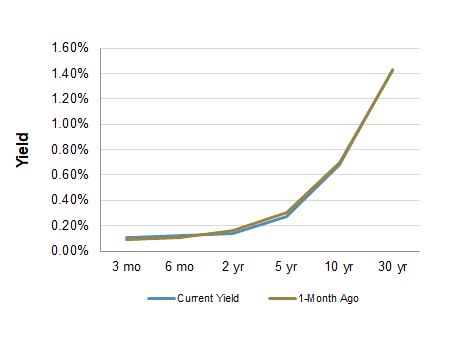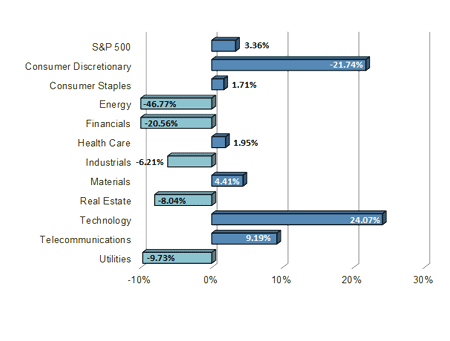Chief Economist Scott Brown discusses the latest market data.
The major stock market indices were choppy on a day-to-day basis, as investors continued to reevaluate the rally off the lows. The economic data reports were inconsequential.
The Consumer Price Index rose 0.4% in August (-0.2% y/y), also up 0.4% excluding food & energy (+0.3% y/y), boosted partly by a 5.4% increase in the index for used cars and trucks. The Producer Price Index rose 0.3% in August (-0.2% y/y), up 0.3% excluding food, energy and trade services (+0.3% y/y). There were mixed signs of pipeline inflation pressures at the earlier stages of production. Ex-food & energy, the index for processed intermediate goods rose 0.5% (-1.1% y/y) and the index for unprocessed intermediate goods rose 1.7% (+5.7% y/y). Lumber rose 10.5% (+27.6% y/y, most of that in the last three months). Jobless claims, a leading economic indicator, totaled 885,000 in the week ending September 5, the second week under the revised seasonal adjustment – still extremely high by historical standards (although less horrific than in March and April).
Next week, the focus is expected to be on the Fed, not that there is any suspense about what they will do (leave short-term interest rates unchanged). Instead, financial market participants will look to the Fed’s revised economic projections and Powell’s press conference. The Fed should recognize that the initial rebound from the social distancing effects of March and April was relatively strong in May, June and July – but that’s still only a partial recovery and the pace of improvement in the economy appeared to slow in August. The mid-month data (retail sales, industrial production) should reinforce that view. In his press conference, Chair Powell is expected to speak further on the Fed’s revised monetary policy framework. Residential construction figures for August should be strong.
Indices
| Last | Last Week | YTD return % | |
|---|---|---|---|
| DJIA | 27534.58 | 28292.73 | -3.52% |
| NASDAQ | 10919.59 | 11458.10 | 21.70% |
| S&P 500 | 3339.19 | 3455.06 | 3.36% |
| MSCI EAFE | 1897.15 | 1899.02 | -6.86% |
| Russell 2000 | 1507.75 | 1544.68 | -9.63% |
Consumer Money Rates
| Last | 1 year ago | |
|---|---|---|
| Prime Rate | 3.25 | 5.25 |
| Fed Funds | 0.08 | 2.10 |
| 30-year mortgage | 2.89 | 3.70 |
Currencies
| Last | 1 year ago | |
|---|---|---|
| Dollars per British Pound | 1.2805 | 1.233 |
| Dollars per Euro | 1.1815 | 1.101 |
| Japanese Yen per Dollar | 106.13 | 107.82 |
| Canadian Dollars per Dollar | 1.319 | 1.319 |
| Mexican Peso per Dollar | 21.443 | 19.509 |
Commodities
| Last | 1 year ago | |
|---|---|---|
| Crude Oil | 37.30 | 55.75 |
| Gold | 1964.30 | 1503.20 |
Bond Rates
| Last | 1 month ago | |
|---|---|---|
| 2-year treasury | 0.14 | 0.16 |
| 10-year treasury | 0.68 | 0.70 |
| 10-year municipal (TEY) | 1.26 | 0.95 |
Treasury Yield Curve – 09/11/2020

As of close of business 09/10/2020
S&P Sector Performance (YTD) – 09/11/2020

Economic Calendar
| September 10 | — | Jobless Claims (week ending September 5) |
| — | Producer Price Index (August) | |
| September 11 | — | Consumer Price Index (August) |
| September 15 | — | Industrial Production (August) |
| September 16 | — | Retail Sales (August) |
| — | FOMC Policy Decision | |
| October 29 | — | Real GDP (3Q20, advance estimate) |
| November 3 | — | Election Day |
| November 5 | — | FOMC Policy Decision |
All expressions of opinion reflect the judgment of the Research Department of Raymond James & Associates, Inc. and are subject to change. There is no assurance any of the forecasts mentioned will occur or that any trends mentioned will continue in the future. Investing involves risks including the possible loss of capital. Past performance is not a guarantee of future results. International investing is subject to additional risks such as currency fluctuations, different financial accounting standards by country, and possible political and economic risks, which may be greater in emerging markets. While interest on municipal bonds is generally exempt from federal income tax, it may be subject to the federal alternative minimum tax, and state or local taxes. In addition, certain municipal bonds (such as Build America Bonds) are issued without a federal tax exemption, which subjects the related interest income to federal income tax. Municipal bonds may be subject to capital gains taxes if sold or redeemed at a profit. Taxable Equivalent Yield (TEY) assumes a 35% tax rate.
The Dow Jones Industrial Average is an unmanaged index of 30 widely held stocks. The NASDAQ Composite Index is an unmanaged index of all common stocks listed on the NASDAQ National Stock Market. The S&P 500 is an unmanaged index of 500 widely held stocks. The MSCI EAFE (Europe, Australia, Far East) index is an unmanaged index that is generally considered representative of the international stock market. The Russell 2000 index is an unmanaged index of small cap securities which generally involve greater risks. An investment cannot be made directly in these indexes. The performance noted does not include fees or charges, which would reduce an investor’s returns. U.S. government bonds and treasury bills are guaranteed by the US government and, if held to maturity, offer a fixed rate of return and guaranteed principal value. U.S. government bonds are issued and guaranteed as to the timely payment of principal and interest by the federal government. Treasury bills are certificates reflecting short-term (less than one year) obligations of the U.S. government.
Commodities trading is generally considered speculative because of the significant potential for investment loss. Markets for commodities are likely to be volatile and there may be sharp price fluctuations even during periods when prices overall are rising. Specific sector investing can be subject to different and greater risks than more diversified investments. Gross Domestic Product (GDP) is the annual total market value of all final goods and services produced domestically by the U.S. The federal funds rate (“Fed Funds”) is the interest rate at which banks and credit unions lend reserve balances to other depository institutions overnight. The prime rate is the underlying index for most credit cards, home equity loans and lines of credit, auto loans, and personal loans. Material prepared by Raymond James for use by financial advisors. Data source: Bloomberg, as of close of business September 10, 2020.
Markets & Investing Members of the Raymond James Investment Strategy Committee share their views on...
Markets & Investing Review the latest Weekly Headings by CIO Larry Adam. Key Takeaways ...
Technology & Innovation Learn about a few simple things you can do to protect your personal information...